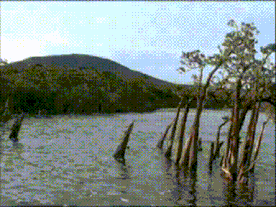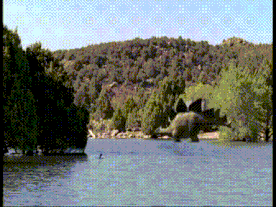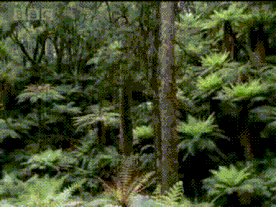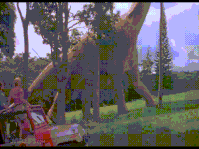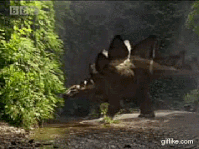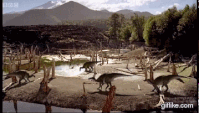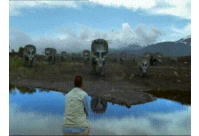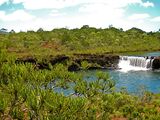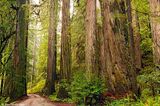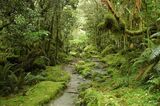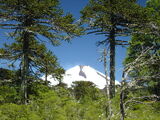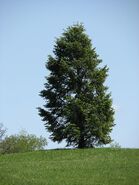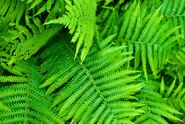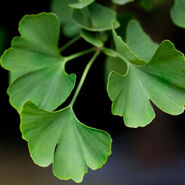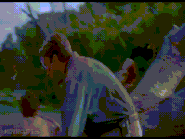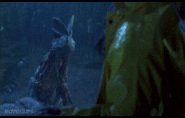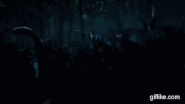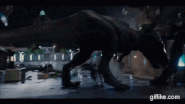No edit summary Tag: rte-wysiwyg |
No edit summary |
||
| (3 intermediate revisions by 2 users not shown) | |||
| Line 1: | Line 1: | ||
| − | + | They were towering, tiny, friendly, and fierce. The dinosaurs were one of the most extraordinary creatures on our planet in the past. First evolving from 230 million years ago and becoming extinct around 66 million years ago. So they have been on Earth for more than 160 million years. But how do we know about their size, their feeding habits, their habitat and the extinction of the species, paleontologists (a scientist who studies fossils and ancient lifeforms) have found thousands of their skeletons and fossils worldwide. Now thanks to their research, their theories, and 21st-century technology, we have made them peaceful giants from the books to blood-thirsty killers in sci-fi films. With the information and analysis we have collected, we have a pretty good idea of what they looked like, how they behaved, and what was on their daily menu. Now here's your chance to do some paleontological studies of your own. |
|
==How to use the dino guide. == |
==How to use the dino guide. == |
||
Click on one of these time periods during the Mesozic Era, the time of the dinosaurs, and study on over 40 species of these magestic reptiles. Learn about everything from their feeding habits, to their characteristics and their place in pop culture ( movies, tv shows, etc.). |
Click on one of these time periods during the Mesozic Era, the time of the dinosaurs, and study on over 40 species of these magestic reptiles. Learn about everything from their feeding habits, to their characteristics and their place in pop culture ( movies, tv shows, etc.). |
||
<gallery widths="155" spacing="small" orientation="portrait" navigation="true"> |
<gallery widths="155" spacing="small" orientation="portrait" navigation="true"> |
||
| − | Triassic Period.gif|Triassic Period (252.1 - 201. 3 million years ago)|link=Triassic Period |
+ | Triassic Period.gif|Triassic Period (252.1 - 201. 3 million years ago)|link=Triassic Period |
| − | Jurassic Period.gif|Jurassic Period (201.3 - 154 million years ago)|link= |
+ | Jurassic Period.gif|Jurassic Period (201.3 - 154 million years ago)|link=Jurassic Period |
| − | Creataceous scenary.gif|Cretaceous Period (145 - 65 million years ago)|link= |
+ | Creataceous scenary.gif|Cretaceous Period (145 - 65 million years ago)|link=Cretaceous Period |
</gallery> |
</gallery> |
||
| Line 12: | Line 12: | ||
===Flesh on the Bones=== |
===Flesh on the Bones=== |
||
| + | Since there have been thousands of skeletons that have been discovered, and with a new fossils being found every 7 weeks. We have being studing the bones to see how the muscles, tendons, nerves and blood vessels were arranged on the bones. However, laying skin over all the muscle is a matter of guess work. From the tiniest amount of skin impressions found, palentologists have concluded that their skin was |
||
| − | This paragraph will describe what the animals would have looked like when their skeleton is complete is with muscles and skin, however color is just a matter of guess work. |
||
| + | much like reptiles, which is scaly, tough, and waterproof. But to adapt and blend in with the environment around them, they had to have a differet varitey of colors and textures such as ridges and stripes, and since blending in was important, poka-a-dots were ruled out. So in the pop culutural world, all dinosaurs had different skin designs. |
||
<gallery orientation="none" widths="302" spacing="small"> |
<gallery orientation="none" widths="302" spacing="small"> |
||
| − | Raptos Unskined.gif|Under the Skin of a predator, |
+ | Raptos Unskined.gif|Under the Skin of a predator, |
</gallery> |
</gallery> |
||
====Different Types of Dinosaurs==== |
====Different Types of Dinosaurs==== |
||
Besides herbivores and carnivores, there are 5 groups of these creatures. Those groups are theropods (walking on two legs), Sauropodomorphs (long legged herbivores), Thyreophorans ("shield bearers", plates or large scales on back, clubs or spikes on tale), Ornithopods (hadrosaurs), and Marginocephalians (hard heads made of bone, three horns and a frill or ceratopsins). |
Besides herbivores and carnivores, there are 5 groups of these creatures. Those groups are theropods (walking on two legs), Sauropodomorphs (long legged herbivores), Thyreophorans ("shield bearers", plates or large scales on back, clubs or spikes on tale), Ornithopods (hadrosaurs), and Marginocephalians (hard heads made of bone, three horns and a frill or ceratopsins). |
||
| + | |||
| + | |||
| + | {| border="0" cellpadding="1" cellspacing="1" class="article-table" style="margin: 0px auto; width: 500px;" |
||
| + | |+Dinosaur Types |
||
| + | |- |
||
| + | ! scope="col"|Species Name |
||
| + | ! scope="col"|Pronounced |
||
| + | ! scope="col"|Special Features |
||
| + | ! scope="col"|Featured Species |
||
| + | |- |
||
| + | |Theropod |
||
| + | |theer-uh-pod |
||
| + | |strong head legs, small front limbs, and strong jaws (mainly carnviourous) |
||
| + | |24 |
||
| + | |- |
||
| + | |Sauropodmorphs |
||
| + | |sawr-uh-pod-morphs |
||
| + | |large necks, large amount of weight and size |
||
| + | |5 |
||
| + | |- |
||
| + | |Thyreophorans |
||
| + | |thyr'e-oph'orans |
||
| + | |bony plates or armored back and tail defenses |
||
| + | |2 |
||
| + | |- |
||
| + | |Ornithopods |
||
| + | |Or-nith'o-pod |
||
| + | |Duck billed dinosaurs |
||
| + | |7 |
||
| + | |- |
||
| + | |Marginocephalians |
||
| + | |Mar'gi-no-ce-phal'i-an |
||
| + | |head armor (thick skull or three horns and a frill) |
||
| + | |5 |
||
| + | |} |
||
| + | |||
<gallery widths="199" captiontextcolor="#27bb0a"> |
<gallery widths="199" captiontextcolor="#27bb0a"> |
||
Dinosaur 01.gif|Theropod (Carnotaurus) |
Dinosaur 01.gif|Theropod (Carnotaurus) |
||
| Line 24: | Line 61: | ||
Stegosaurus.gif|Thyreophoran (Stegosaurus) |
Stegosaurus.gif|Thyreophoran (Stegosaurus) |
||
Edmontosaurus 02.gif|Ornithopod (Edmontosaurus) |
Edmontosaurus 02.gif|Ornithopod (Edmontosaurus) |
||
| − | + | Marginocephalians.gif|Marginocephalians |
|
</gallery> |
</gallery> |
||
=== <span style="font-size:16px;">The Right Environment</span>=== |
=== <span style="font-size:16px;">The Right Environment</span>=== |
||
| + | Since the dinosaurs have disappeared from the planet, so did there habitats. Just because the landscapes have changed over 65 million years, doesn't mean that science doesn't have a clue of what it was like back then. So when palentologist dig up the skeletons, they try to find any kind of flaura that has been fossilized. What they find and identify is pretty shocking to the paletonology world, they have uncovered leaves or cones that belong to the world's largest trees, such as sequoia and redwood trees and some other species that live in tropical environments. So the areas were completely different than it was today. |
||
| − | This paragraph will exaime the animals environmental standards. Even though we don't know what the environments looked like, we could have a guess of what they looked like. |
||
| ⚫ | |||
| ⚫ | |||
| − | Jurassic forest.jpg|Redwood Forest of California - Jurassic Period |
||
| − | Chile.jpg|Ashfields and Araucaria forest in Chile, Cretaceous Period |
||
| ⚫ | |||
| ⚫ | |||
| − | With the skeleton fully covered with muscle and skin, its time to put them on the move. Inside the computer, the skeletons are put into practice as the walk, run, swim and fly again. Once they're walking again, they're being put back into their environment. They may be suitable in there habitats, but how will they survive? |
||
| + | For film makers, they had to find the best places that seem like dinosaurs would feel like home. For example, for Tim Hanes' series "Walking with Dinosaurs." |
||
| − | <gallery> |
+ | <gallery spacing="small" widths="160"> |
| ⚫ | |||
| − | Computer Model.jpeg|Tyrannosaurus "Chicken Wire" Model |
||
| + | California State Park (Time of the Titans).jpg|California State Parks (Late Jurassic Period forests) |
||
| − | King on the Move again.gif|Tyrannosaurus walking again |
||
| + | New Zealand (Spirts of the Ice Forest).jpg|New Zealand (Early Cretaceous period |
||
| − | Male looking for food..gif|King is home. |
||
| + | Environment 01.jpg|Chile, South America (Late Cretaceous Period) |
||
</gallery> |
</gallery> |
||
| ⚫ | |||
| − | ===Feeding Time |
||
| + | With the skeletons uncovered and the right environment located, it's time to put the |
||
| + | creatures back into the wild. But with the fossils in suspended animation, how can |
||
| + | filmakers bring them back to life? To find out how these ancient creatures used to walk, animators would first use modern animals to see how their way of life affect they're movement and how does the shape of their body affect their movement. |
||
| ⚫ | |||
| + | Diplodocus computer model.gif|Diplodocus walking model |
||
| + | Sauropods.gif|Final Diplodocus movement |
||
| ⚫ | |||
| + | <span style="font-size:13px;">Just like the modern animals today, the dinosaurs ate in two groups. The most common ones were the herbivores and according to palentologists, most of the herbivores had different eating styles and they digested the most nutrious plants that they could find. The top plants around were conifers tree leaves, ferns and ginkos. However, grass was never around during the Mesozic Era, so they could browse like todays modern cows and deer. Also, most of them didn't chew until the mid-cretacous period when the duck bill hadosaurs were around. Before the hadosaurs, most of the other like sauropods swallowed their food whole and swallowed stones to help them digest.</span> |
||
| − | <span style="font-size:13px;">Basically there are two feeding habits that the dinosaurs had, the herbivores have devised ways to break down the toughest plant material. Since grass never evolved in the Mesozic Era, these are the three plants that the herbivores had to eat. </span>=== |
||
<gallery> |
<gallery> |
||
| Line 60: | Line 99: | ||
Rexy Hunt.gif|Ambush Attack |
Rexy Hunt.gif|Ambush Attack |
||
Dilophosaurus Spit.gif|Biological Weapon |
Dilophosaurus Spit.gif|Biological Weapon |
||
| − | Late Night Hunting.gif| |
+ | Late Night Hunting.gif|Pack Hunting |
Carnotaur Attack 02.gif|Chase down and exhaust their prey. |
Carnotaur Attack 02.gif|Chase down and exhaust their prey. |
||
</gallery> |
</gallery> |
||
| Line 86: | Line 125: | ||
<p style="text-align:right;">[[File:The Magic School Bus E16 The Busasaurus|thumb|left|220px|Magic School Bus - The Busasaurus]]</p> |
<p style="text-align:right;">[[File:The Magic School Bus E16 The Busasaurus|thumb|left|220px|Magic School Bus - The Busasaurus]]</p> |
||
| − | <p style="text-align:center;" |
+ | <p style="text-align:center;"> |
| + | </p> |
||
| − | |||
| − | 1. Scientists who study fossils to learn about the history of the Earth are called: |
||
| − | |||
| − | a. fossilists b. paletonologists c. biologists |
||
| − | |||
| − | 2. A T- Rex is believed to eat its own weight in meat each week. That would amount to a total of 12 cows, or: |
||
| − | |||
| − | a. 7 tons b. 10 tons c. 12 tons |
||
Latest revision as of 19:06, 23 April 2020
They were towering, tiny, friendly, and fierce. The dinosaurs were one of the most extraordinary creatures on our planet in the past. First evolving from 230 million years ago and becoming extinct around 66 million years ago. So they have been on Earth for more than 160 million years. But how do we know about their size, their feeding habits, their habitat and the extinction of the species, paleontologists (a scientist who studies fossils and ancient lifeforms) have found thousands of their skeletons and fossils worldwide. Now thanks to their research, their theories, and 21st-century technology, we have made them peaceful giants from the books to blood-thirsty killers in sci-fi films. With the information and analysis we have collected, we have a pretty good idea of what they looked like, how they behaved, and what was on their daily menu. Now here's your chance to do some paleontological studies of your own.
How to use the dino guide.
Click on one of these time periods during the Mesozic Era, the time of the dinosaurs, and study on over 40 species of these magestic reptiles. Learn about everything from their feeding habits, to their characteristics and their place in pop culture ( movies, tv shows, etc.).
Flesh on the Bones
Since there have been thousands of skeletons that have been discovered, and with a new fossils being found every 7 weeks. We have being studing the bones to see how the muscles, tendons, nerves and blood vessels were arranged on the bones. However, laying skin over all the muscle is a matter of guess work. From the tiniest amount of skin impressions found, palentologists have concluded that their skin was much like reptiles, which is scaly, tough, and waterproof. But to adapt and blend in with the environment around them, they had to have a differet varitey of colors and textures such as ridges and stripes, and since blending in was important, poka-a-dots were ruled out. So in the pop culutural world, all dinosaurs had different skin designs.
Different Types of Dinosaurs
Besides herbivores and carnivores, there are 5 groups of these creatures. Those groups are theropods (walking on two legs), Sauropodomorphs (long legged herbivores), Thyreophorans ("shield bearers", plates or large scales on back, clubs or spikes on tale), Ornithopods (hadrosaurs), and Marginocephalians (hard heads made of bone, three horns and a frill or ceratopsins).
| Species Name | Pronounced | Special Features | Featured Species |
|---|---|---|---|
| Theropod | theer-uh-pod | strong head legs, small front limbs, and strong jaws (mainly carnviourous) | 24 |
| Sauropodmorphs | sawr-uh-pod-morphs | large necks, large amount of weight and size | 5 |
| Thyreophorans | thyr'e-oph'orans | bony plates or armored back and tail defenses | 2 |
| Ornithopods | Or-nith'o-pod | Duck billed dinosaurs | 7 |
| Marginocephalians | Mar'gi-no-ce-phal'i-an | head armor (thick skull or three horns and a frill) | 5 |
The Right Environment
Since the dinosaurs have disappeared from the planet, so did there habitats. Just because the landscapes have changed over 65 million years, doesn't mean that science doesn't have a clue of what it was like back then. So when palentologist dig up the skeletons, they try to find any kind of flaura that has been fossilized. What they find and identify is pretty shocking to the paletonology world, they have uncovered leaves or cones that belong to the world's largest trees, such as sequoia and redwood trees and some other species that live in tropical environments. So the areas were completely different than it was today.
For film makers, they had to find the best places that seem like dinosaurs would feel like home. For example, for Tim Hanes' series "Walking with Dinosaurs."
On the Move
With the skeletons uncovered and the right environment located, it's time to put the creatures back into the wild. But with the fossils in suspended animation, how can filmakers bring them back to life? To find out how these ancient creatures used to walk, animators would first use modern animals to see how their way of life affect they're movement and how does the shape of their body affect their movement.
Feeding Time
Just like the modern animals today, the dinosaurs ate in two groups. The most common ones were the herbivores and according to palentologists, most of the herbivores had different eating styles and they digested the most nutrious plants that they could find. The top plants around were conifers tree leaves, ferns and ginkos. However, grass was never around during the Mesozic Era, so they could browse like todays modern cows and deer. Also, most of them didn't chew until the mid-cretacous period when the duck bill hadosaurs were around. Before the hadosaurs, most of the other like sauropods swallowed their food whole and swallowed stones to help them digest.
Going Hunting
To understand how the carnivores should requires a different strategy, there food didnt grow on trees so the key question was: "How did they hunt?" By judging the skeletons and research, there are four ways that the carnivores could've hunted and killed their prey. Either they can use an ambush or surprise attack to confuse their prey. Biological weapons, like Dilophosaurus venom or Tyrannosaurus saliva. Working together in a group or pack, like most small carnivores like the raptors or chasing down the prey until they're slow enough and exhuasted. A predator who uses these techinques can be successful at catching there prey.
Love, Not War
Every dinosaur is different, but not when it comes to battling for or attracting a mate. So how exactly did the males compete against other males, fight off other species and who do they attract the opposite gender of their species. Once the couple have been together for a while, they can begin to breed more of their own species, or have young of there own, How many eggs can the female lay and when is their incubation period? Also, once hatched, how does the adults take of the young until the are mature enough to be on their own and how does it take for the junville to grow until it reaches its full size.
Videos
These videoes can be helpful for children. Worksheets to the videos will be up A.S.A.P.
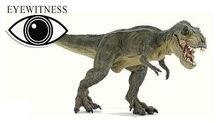
EYEWITNESS Dinosaur
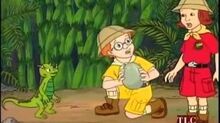
The Magic School Bus E16 The Busasaurus
Magic School Bus - The Busasaurus
